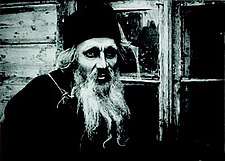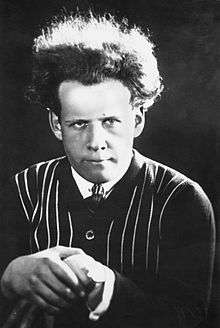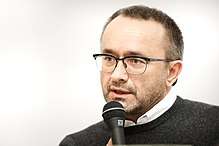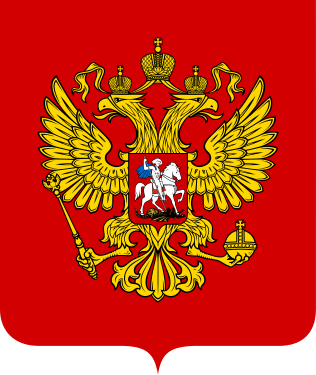Cinema of Russia
The cinema of Russia began in the Russian Empire, widely developed in the Soviet Union and in the years following its dissolution, the Russian film industry would remain internationally recognized. In the 21st century, Russian cinema has become popular internationally with hits such as House of Fools, Night Watch and Brother. The Moscow International Film Festival began in Moscow in 1935. The Nika Award is the main annual national film award in Russia.
| Cinema of Russia | |
|---|---|
Salyut cinema in Yekaterinburg | |
| No. of screens | 4,372 (2016)[1] |
| • Per capita | 2.1 per 100,000 (2011)[2] |
| Main distributors | Central Partnership (26.6%) WDSSPR (19.5%) 20th Century Fox (Disney) (16.1%) [3] |
| Produced feature films (2016)[1] | |
| Total | 101 |
| Number of admissions (2016)[1] | |
| Total | 193,500,000 |
| • Per capita | 1.2 (2012)[4] |
| National films | 32,100,000 (16.8%) |
| Gross box office (2016)[1] | |
| Total | US$722.5 million |
| National films | 15.5% |
Cinema of the Russian Empire

The first films seen in the Russian Empire were brought in by the Lumière brothers, who exhibited films in Moscow and St. Petersburg in May 1896. That same month, Lumière cameraman Camille Cerf made the first film in Russia, recording the coronation of Nicholas II at the Kremlin.
Aleksandr Drankov produced the first Russian narrative film Stenka Razin, based on events told in a popular folk song and directed by Vladimir Romashkov. Ladislas Starevich made the first Russian animated film (and the first stop motion puppet film with a story) in 1910 – Lucanus Cervus. Among the notable Russian filmmakers of the era were Aleksandr Khanzhonkov and Ivan Mozzhukhin, who made Defence of Sevastopol in 1912. Yakov Protazanov made Departure of a Grand Old Man, a biographical film about Lev Tolstoy.
During World War I, imports dropped drastically, and Russian filmmakers turned out anti-German, nationalistic films. In 1916, 499 films were made in Russia, more than three times the number of just three years earlier.
The Russian Revolution brought more change, with a number of films with anti-Tsarist themes. The last significant film of the era, made in 1917, Father Sergius would become the first new film release of the Soviet era.
Cinema of the Soviet Union
Early Soviet cinema (1917-1953)

Although Russian was the dominant language in films during the Soviet era, the cinema of the Soviet Union encompassed films of the Armenian SSR, Georgian SSR, Ukrainian SSR, and, to a lesser degree, Lithuanian SSR, Belorussian SSR and Moldavian SSR. For much of the Soviet Union's history, with notable exceptions in the 1920s and the late 1980s, film content was heavily circumscribed and subject to censorship and bureaucratic state control.
The development of the soviet film industry was highly innovative and linked with the Constructivist art movement. In 1922-3, Kino-Fot became the first Soviet cinema magazine and reflected the constructivist views of its editor, Aleksei Gan.
As with much Soviet art during the 1920s, films addressed major social and political events of the time. Probably the single most important film of this period was Sergei Eisenstein's The Battleship Potemkin, not only because of its depiction of events leading up to the 1905 Revolution, but also because of innovative cinematic techniques, such as the use of jump-cuts to achieve political ends. Other notable films of the period include Vsevolod Pudovkin's Mother (1926) and Dziga Vertov's Man with a Movie Camera (1929).
However, with the consolidation of Stalinist power in the Soviet Union, and the emergence of Socialist realism as state policy, which carried over from painting and sculpture into filmmaking, Soviet film became subject to almost total state control.
Popular films released in the 1930s include the musicals Circus, Jolly Fellows and Volga-Volga starring leading actress of the time Lyubov Orlova.
In the 1930s and the 1940s Eisenstein directed two historical epics – Aleksandr Nevsky (1938) and Ivan the Terrible (1944).
Immediately after the end of the Second World War, the Soviet color films such as The Stone Flower (1947), Ballad of Siberia (1947), and Cossacks of the Kuban (1949) were released. Soviet films achieved significant critical success from the 1950s onwards partly as a result, similar to the cinema of other Eastern Bloc countries, for reflecting the tension between independent creativity and state-directed outcomes.
Late Soviet cinema (1953-1991)
In the late 1950s and early 1960s Soviet film-makers were given a less constricted environment, and while censorship remained, films emerged which began to be recognised outside the Soviet bloc such as Ballad of a Soldier which won the 1961 BAFTA Award for Best Film and the 1958 Palme d'Or winning The Cranes Are Flying. The Height (1957) is considered to be one of the best films of the 1950s (it also became the foundation of the Bard movement). Yet, some important films did not receive a wide release; The Story of Asya Klyachina (1966), Commissar (1967), Brief Encounters (1967).
The most critically acclaimed Russian director of the 1960s and 1970s was Andrei Tarkovsky, who directed the groundbreaking art-house films Ivan's Childhood, Andrei Rublev, Solaris, Mirror and Stalker.
Most popular Soviet movies of the era were comedies such as Carnival Night (1956), The Irony of Fate (1976), Kidnapping, Caucasian Style (1967), Operation Y and Shurik's Other Adventures (1965), The Twelve Chairs (1976), Walking the Streets of Moscow (1964), Gentlemen of Fortune (1971).
"Osterns", the Soviet Union's own take on the Western genre, became also popular. Examples of the Ostern include White Sun of the Desert (1970), The Headless Horseman (1972), Armed and Dangerous (1977), A Man from the Boulevard des Capucines (1987).
.jpg)
A respective amount of World War II dramas made in the 1970s and the 1980s were acclaimed internationally, some of which are Liberation (1971), The Dawns Here Are Quiet (1972), They Fought for Their Country (1975), The Ascent (1977) and Come and See (1985).
In the 1980s acclaimed Russian director Andrei Konchalovsky was the first filmmaker to find success in Hollywood. In America he directed Maria's Lovers, Runaway Train and Tango & Cash.
With the onset of Perestroika and Glasnost in the mid-1980s, Soviet films emerged which began to address formerly censored topics, such as drug addiction, The Needle, and sexuality and alienation in Soviet society, Little Vera.
Several Soviet films have received Oscars; War and Peace, Dersu Uzala, Moscow Does Not Believe in Tears.
Some of the popular actors of the Soviet period were Innokenty Smoktunovsky, Oleg Yankovsky, Andrei Mironov, Nikita Mikhalkov, Vladimir Vysotsky, Vasily Lanovoy, Tatiana Samoilova, Margarita Terekhova, Barbara Brylska, Yelena Koreneva.
New Russian cinema
1990s
Russian cinema of the 90s acquired new features and themes. Many films of that time dealt with Stalinism.
The Chekist directed by Aleksandr Rogozhkin was a drama set in the period of Red Terror and told the story of a Cheka leader who gradually becomes unhinged. It was screened in the Un Certain Regard section at the 1992 Cannes Film Festival.
The drama Burnt by the Sun (1994) by Nikita Mikhalkov is set in a small countryside community in the time when Stalinism starts to disrupt their idyllic retreat and alter their characters and fates. The film received an Oscar for Best Foreign Language Film and the Grand Prix du Jury at the 1994 Cannes Film Festival.
In the context of the Russian World War II history Pavel Chukhrai filmed The Thief (1997), a movie about a mother who becomes romantically involved with a criminal who impersonates an officer. The film was awarded with 6 national prizes Nika, got a special prize in Venice and became the Oscar nominee.
One of the first commercially successful post-Soviet films was the crime drama Brother directed by Aleksei Balabanov. It was screened as part of the Un Certain Regard section at the 1997 Cannes Film Festival.
Valery Todorovsky's The Country of the Deaf (1998), a comedy film based on the screenplay by Renata Litvinova parodied Russia of the 90s. It described the journey of two female friends caught in the fight of two clans - the deaf and the hearing. It was entered in the 48th Berlin International Film Festival.
In 1997 Aleksandr Sokurov had his international breakthrough with the arthouse drama Mother and Son. It won the Special Silver St. George at the 20th Moscow International Film Festival in 1997.
1998 film Khrustalyov, My Car! directed by Aleksei German described the last days of Stalinist Russia. It was entered in the 1998 Cannes Film Festival.
Internationally co-produced film East/West (1999) starring Sandrine Bonnaire and Catherine Deneuve told the story of an emigre family living in Stalinist USSR.
The satiric melodrama of Dmitry Meskhiev, Women's Property (1999) describes a love affair between a young student and an older actress who is incurably ill. Her death leads the protagonist to face bitter loneliness. The film featured actor Konstantin Khabensky in an early lead role.
Cult crime comedy 8 ½ $ (1999) starring Ivan Okhlobystin and Fyodor Bondarchuk was a satiric take on 1990s Russia. It told the story of a television advertisement director who becomes romantically involved with a gangster's girlfriend.
2000s
.jpg)
Andrey Zvyagintsev's The Return (2003), a Golden Lion award recipient, shows two brothers' test of life when their father suddenly returns that reaches a deep almost-mystic pitch.
The Russian Ark (2003) by Alexander Sokurov, was filmed in a single 96-minute shot in the Russian Hermitage Museum is a dream-like narration that tells about Classic Russian culture sailing in the Ark.
The Night Watch was one of the first blockbusters made after the collapse of the Soviet film industry, it was a 2004 supernatural thriller directed by Timur Bekmambetov starring Konstantin Khabensky based on the eponymous book by Sergei Lukyanenko. It was followed by the sequel Day Watch (2006).
The serialised novels by Boris Akunin set in pre-Revolutionary Russia evolve around fictional Erast Fandorin adventures in three popular movies: The Azazel (2002), The Turkish Gambit (2005) and The State Counsellor (2005).
Life of the Orthodox Monastery and their Christian miracles are described in the film The Island (2006) by Pavel Lungin. The film was screened out of the competition at the 63rd Venice International Film Festival and received the Golden Eagle and Nika awards.
One of Russia's all-time biggest box-office hits was Timur Bekmambetov's romantic-comedy The Irony of Fate 2, directed in 2007 as a sequel to the 1976 film.
2008 musical film Stilyagi, Hipsters directed by Valery Todorovsky about the youth lifestyle in the 1950s Soviet Union was a success at the box office. It received the Golden Eagle and Nika awards for best picture.
2010s

In 2010 the comedy anthology film Yolki produced by Timur Bekmambetov was released. It spawned five sequels and one spin-off.
How I Ended This Summer by Alexei Popogrebski a film shot in remote Chukotka won Berlin's Film Festival Golden Bear in 2010.
The same year arthouse film Silent Souls by Aleksey Fedorchenko won the Golden Osella at the Venice Film Festival for best cinematography.
One of the most successful movies made with Hollywood actors was the 2011 comedy Lucky Trouble where Milla Jovovich plays the female lead.
In recent years the most important Russian filmmaker to enter Hollywood is Timur Bekmambetov, a producer and director of blockbuster films. In the United States he directed Abraham Lincoln: Vampire Hunter (2012) and Ben-Hur (2016).
War epic Stalingrad directed by Fyodor Bondarchuk in 2013 set new box-office records in Russia and abroad.
In 2014, Andrey Zvyagintsev's Leviathan was entered in the 2014 Cannes Film Festival and nominated for best foreign picture at the 87th Academy Awards. It won the Golden Globe for best foreign language film.
Andrei Konchalovsky received the Silver Lion for best director at the 73rd Venice International Film Festival for his black and white Holocaust drama Paradise in 2016. He previously received the Silver Lion for The Postman's White Nights in 2014.
Disaster film Flight Crew, directed by Nikolay Lebedev with actor Danila Kozlovsky was a big success at the box-office in 2016.
The 2017 sports drama Going Vertical by Anton Megerdichev is the most profitable film of the 2010s period.
Starting from 2003 Russia's animation industry began to manufacture films which are profitable domestically and abroad. Some of the pictures are The Snow Queen 1, 2, 3, Masha and the Bear, Kikoriki, Dobrynya Nikitich and Zmey Gorynych.
In the recent years many Russian films have gotten wide releases in China,[5][6][7] and there has been an increased number of planned Russo-Chinese co-productions.[8] A few of the films produced by Russia and China are Viy, Viy 2: Journey to China starring Jackie Chan and Arnold Schwarzenegger,[9] The Snow Queen 3: Fire and Ice[10] and Quackerz.[11]
The most popular actors of the 2000s-2010s period are Konstantin Khabensky, Danila Kozlovsky, Aleksei Serebryakov, Kseniya Rappoport, Fyodor Bondarchuk, Elizaveta Boyarskaya, Sergey Bezrukov, Yevgeny Mironov and Ivan Okhlobystin.
Russian film production
There are around 400 private production companies. They do not have their own facilities for creating films that is why they rent out spaces and equipment from their qualified partners. There are 35 film studios (9 of them are governmental) that are the major service for renting space. The studios have 107 shooting pavilions. There are 23 private companies on the Russian market that rent their equipment of all kinds to the production teams.[12]
Leading production companies on the market
The list is composed by the Cinema Foundation of Russia. It allows companies get governmental financial support. In 2017 the number of market leaders was increased up to 10 companies.[13]
- Bazelevs Company run by Timur Bekmambetov
- Art Pictures Studio run by Fyodor Bondarchuk and Dmitri Rudovsky
- СТВ run by Sergey Selyanov
- Trite run by Nikita Mikhalkov
- Enjoy Movies run by Andreasyan brothers and Georgy Malkov
- Non-Stop Production run by Alexander Rodnyansky, Sergey Melkumov
- Central Partnership part of Gazprom holding
- Film Direction run by Anatoly Maksimov
- Profit run by Igor Tolstunov
- VBD Group
List of highest-grossing films
According to Kinopoisk.ru, highest-grossing Russian films, as of early 2020, are the following.
Note: This list does not include earlier Soviet films, which are listed separately on the list of highest-grossing films in the Soviet Union.
| Rank | Title | Gross | Year | Genre | Details | Director |
|---|---|---|---|---|---|---|
| 1 | Сталинград |
$68,075,573 | 2013 | War | A World War II film about Battle of Stalingrad | Fyodor Bondarchuk |
| 2 | Ирония судьбы. Продолжение |
$55,639,114 | 2007 | Romantic comedy | A Christmas film, the sequel to a 1976 film of the same name | Timur Bekmambetov |
| 3 | Движение Вверх |
$53,876,764 | 2017 | Sports drama | About 1972 Olympic Men's Basketball Final | Anton Megerdichev |
| 4 | Холоп |
$47,500,000 | 2019 | Comedy | Klim Shipenko | |
| 5 | Вий Viy |
$39,539,416 | 2014 | Fantasy, Horror | Based on a story of the same name by Nikolai Gogol, inspired by Slavic mythology | Oleg Stepchenko |
| 6 | Дневной дозор |
$38,862,717 | 2006 | Fantasy | Based on urban fantasy book series Dozory by Sergey Lukyanenko | Timur Bekmambetov |
| 7 | Адмиралъ Admiral |
$38,135,878 | 2008 | Biography, History | About Russian Civil War monarchist leader, Admiral Alexander Kolchak | Janik Fayziyev |
| 8 | Ёлки 3 |
$38,067,427 | 2013 | Comedy | A Christmas film | Olga Kharina |
| 9 | Ночной дозор |
$33,951,015 | 2004 | Fantasy | Based on urban fantasy book series Dozory by Sergey Lukyanenko | Timur Bekmambetov |
| 10 | Три богатыря на дальних берегах Three Knights at the Distant Shores |
$31,505,876 | 2012 | Animation, Fantasy | An interpretation of medieval Russian folklore | Kostantin Feoktistov (Melnitsa Animation) |
| 11 | Самый лучший фильм |
$30,496,695 | 2008 | Comedy | Spoofing famous Russian films and TV series | Kirill Kuzin |
| 12 | Легенда №17 Legend № 17 |
$29,523,237 | 2013 | Biography, Sport drama | About Soviet hockey player, Valery Kharlamov | Nikolai Lebedev |
| 13 | Обитаемый остров The Inhabited Island |
$27,908,763 | 2009 | Science fiction | Based on a dystopian book by Strugatsky brothers | Fyodor Bondarchuk |
| 14 | Высоцкий. Спасибо, что живой |
$27,544,905 | 2011 | Biography, Drama | About Soviet singer Vladimir Vysotsky | Pyotr Buslov |
| 15 | Ёлки 2 |
$26,231,525 | 2011 | Comedy | A Christmas film | Dmitry Kiselyov, Alexander Kott and others |
| 16 | Викинг |
$25,646,739 | 2016 | History | About Vladimir the Great | Andrei Kravchuk |
| 17 | 9 рота |
$25,555,809 | 2005 | War | About Soviet–Afghan War | Fyodor Bondarchuk |
| 18 | Последний Богатырь The Last Warrior |
$24,965,362 | 2017 | Comic fantasy | An interpretation of medieval Russian folklore | Dmitry Dyachenko |
| 19 | Иван Царевич и серый волк |
$24,830,497 | 2011 | Animation, Fantasy | An interpretation of medieval Russian folklore | Vladimir Toropchin (Melnitsa Animation) |
| 20 | Экипаж |
$23,305,571 | 2016 | disaster film | ||
| 21 | Ёлки |
$22,772,019 | 2010 | Comedy | A Christmas film | Timur Bekmambetov, Dmitry Kiselyov and others |
| 22 | Наша Russia: Яйца судьбы |
$22,213,287 | 2010 | Comedy | Based on a TV show of the same name | Gleb Orlov |
| 23 | Чёрная молния |
$21,500,000 | 2009 | Superhero | Timur Bekmambetov | |
| 24 | Волкодав |
$21,015,154 | 2006 | Fantasy | Based on a medieval high fantasy book by Maria Semenova | Nikolai Lebedev |
| 25 | Иван Царевич и Серый волк 2 |
$20,962,988 | 2013 | Fantasy | An interpretation of medieval Russian folklore | Vladimir Toropchin |
| 26 | Три богатыря. Ход конём |
$19,390,136 | 2015 | Animation, Fantasy | An interpretation of medieval Russian folklore | Konstantin Feoktistov (Melnitsa Animation) |
| 27 | Три богатыря и Шамаханская царица Three Knights and the Queen of Shamakha |
$19,010,585 | 2010 | Animation, Fantasy | An interpretation of medieval Russian folklore | Sergey Glezin (Melnitsa Animation) |
| 28 | Турецкий гамбит |
$18,500,000 | 2005 | History, Spy | Based on a book by Boris Akunin, about espionage at 19th-century Russo-Turkish war | Janik Fayziyev |
| 29 | Притяжение |
$18,400,000 | 2017 | Science fiction | Feodor Bondarchuk | |
| 30 | О чём ещё говорят мужчины |
$17,808,683 | 2011 | Comedy | Starring comic group Quartet I, a sequel to What Men Talk About | Dmitry Dyachenko |
Most expensive Russian films
Below, is a list of the 12 most high-budget Russian films in the history of hire (excluding inflation). The figures given in the January 13, 2018.
| # | Title | Year | Budget, $ |
|---|---|---|---|
| 1 | Viy 2: Journey to China | 2019 | 49,168,000 |
| 2 | Burnt By The Sun 2: Exodus And Citadel | 2010 | 45,000,000 |
| 3 | The Inhabited Island | 2008 | 36,000,000 |
| 4 | The Barber of Siberia | 1998 | 35,000,000 |
| 5 | Stalingrad | 2013 | 30,000,000 |
| 6 | Viy | 2014 | 26,000,000 |
| 7 | Matilda | 2017 | 25,000,000 |
| 8 | Sunstroke | 2014 | 24,000,000 |
| 9 | Admiral | 2008 | 20,000,000 |
| 10 | August Eighth | 2012 | 19,000,000 |
| 11 | Mongol | 2007 | 18,000,000 |
Film distribution
There are 600 companies that release films all around Russia that includes 105 chain cinema theatres and 495 independent theatres. Chain companies consist of 29 federal, 19 regional and 57 local theatres. According to Neva Research, as of 1 July 2016 there were 1,227 cinemas with 4,067 screens in Russia. Ten major cinema companies hold 346 theatres with 1,772 screens, which corresponds to 43.6 % of the whole amount.[14]
In 2015 all the cinemas were finally digitalized. In the beginning of 2016 Russia has 33 theatres with 4D technology, 80 theatres with premium sound system, 43 theatres with 3D IMAX effect.[12]
Festivals
- Moscow International Film Festival
- Kinotavr (in Sochi)
- Pacific Meridian (in Vladivostok)
- Киношок Kinoshock (in Anapa)
Notable cinematography schools
- Gerasimov Institute of Cinematography (self-claimed oldest film school in the world[15])
- New York Film Academy, Moscow campus[16]
- Moscow International Film School[17]
See also
- Nika Award – the main national film award in Russia
- Cinema of the world
- History of Russian animation
- List of Russian films
- Union of Cinematographers of the Russian Federation
References
- "Statistics on the Russian cinema market" (PDF). Nevafilm Research. Retrieved 22 March 2017.
- "Table 8: Cinema Infrastructure - Capacity". UNESCO Institute for Statistics. Retrieved 5 November 2013.
- "Table 6: Share of Top 3 distributors (Excel)". UNESCO Institute for Statistics. Retrieved 5 November 2013.
- "Annual Report 2012/2013" (PDF). Union Internationale des Cinémas. Archived from the original (PDF) on 10 November 2013. Retrieved 10 November 2013.
- "Россия и Китай: делаем кино вместе" (in Russian). filmpro.
- Nick Holdsworth. "Russia's 'Stalingrad' Storms Chinese Box Office". The Hollywood Reporter.
- "Russian fantasy film becomes box office hit in China". RT.
- "Россия и Китай договорились о ста совместных проектах в медиасфере". Ministry of Telecom and Mass Communications of the Russian Federation.
- Leo Barraclough. "Arnold Schwarzenegger, Jackie Chan Join Russian-Chinese Movie 'Viy-2'". Variety.
- Patrick Frater. "Russian and Chinese Companies to Co-Produce 'Snow Queen' Sequel". Variety.
- Vladimir Kozlov. "Russian Animated Film 'Quackerz 3D' Gets Investment From China". The Hollywood Reporter.
- "Состояние российской кинематографии в 2015 году. Отчет Минкультуры". www.proficinema.ru. Retrieved 2017-05-26.
- "Фонд кино расширил список лидеров до 10 кинокомпаний". www.kinometro.ru (in Russian). Retrieved 2017-05-26.
- "Крупнейшие киносети в России (включая франшизы)". Газета "Коммерсантъ" (132). 2016-07-25. p. 7. Retrieved 2017-05-26.
- http://www.vgik.info/international/forprospectivestudents/index.php?SECTION_ID=685 Gerasimov Institute foundation history
- http://www.nyfa.edu/moscow/ NYFA Moscow
- http://www.mifs.ru/index_eng.html Archived 2017-10-30 at the Wayback Machine Moscow International Film School homepage, translated
External links
- Russian film titles at the Internet Movie Database
